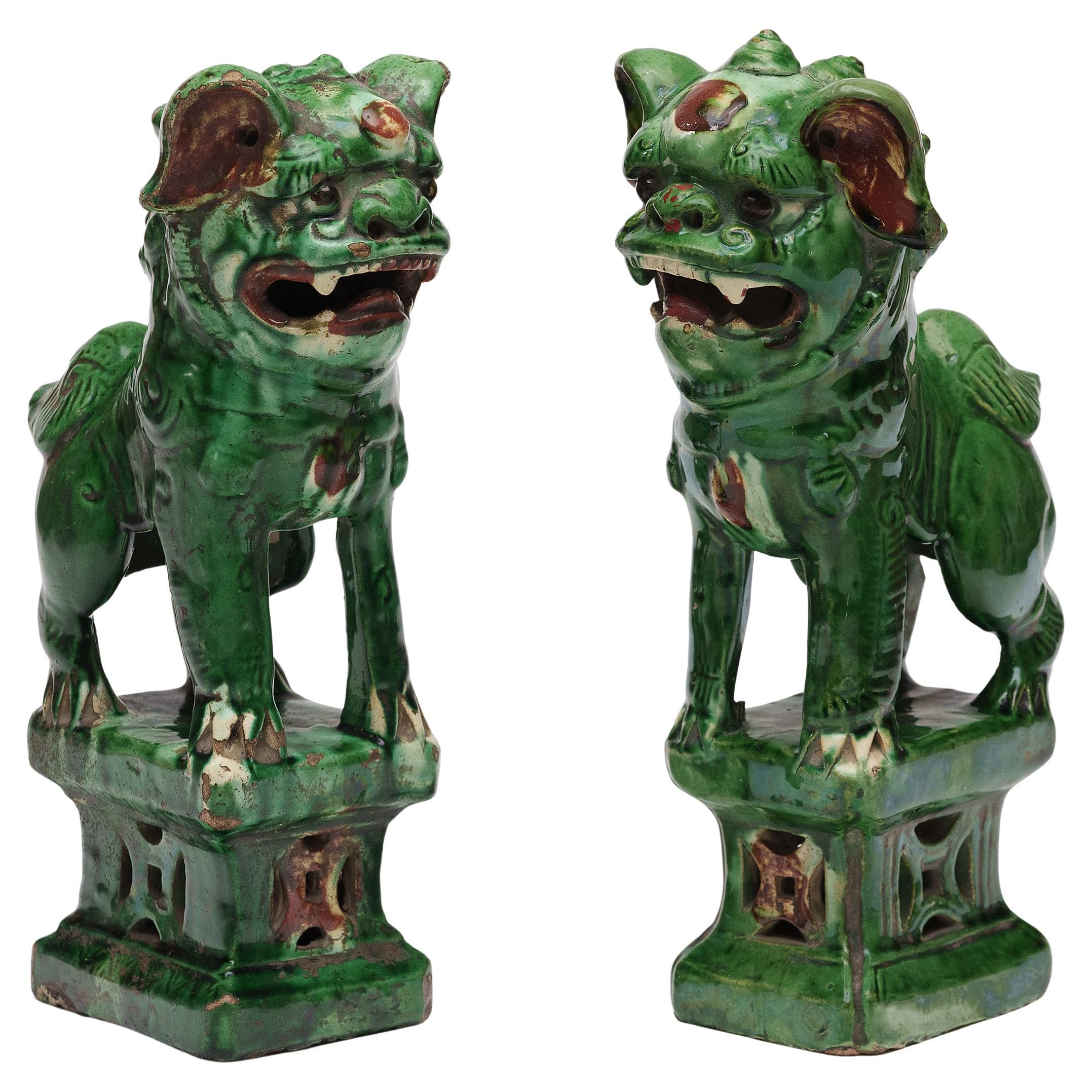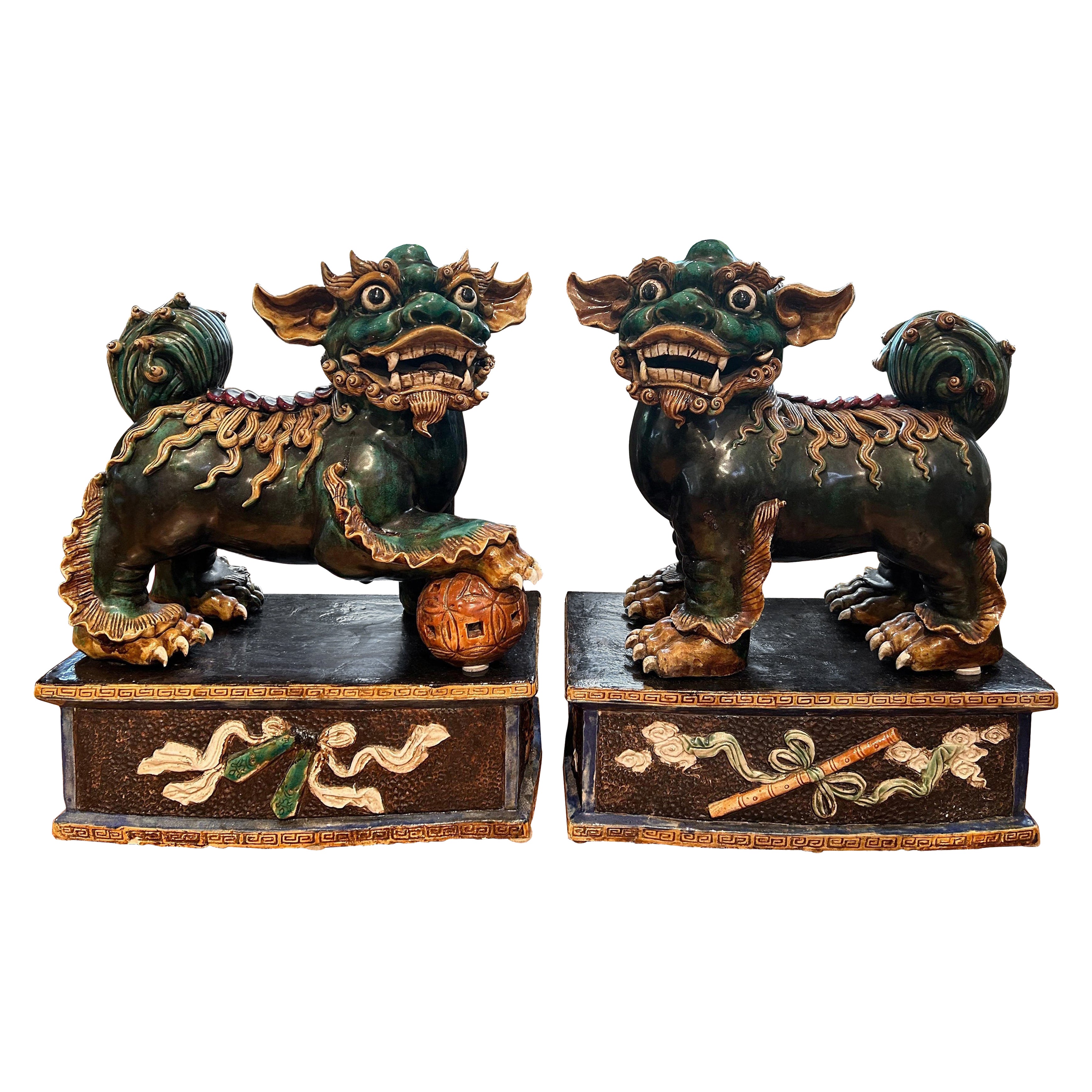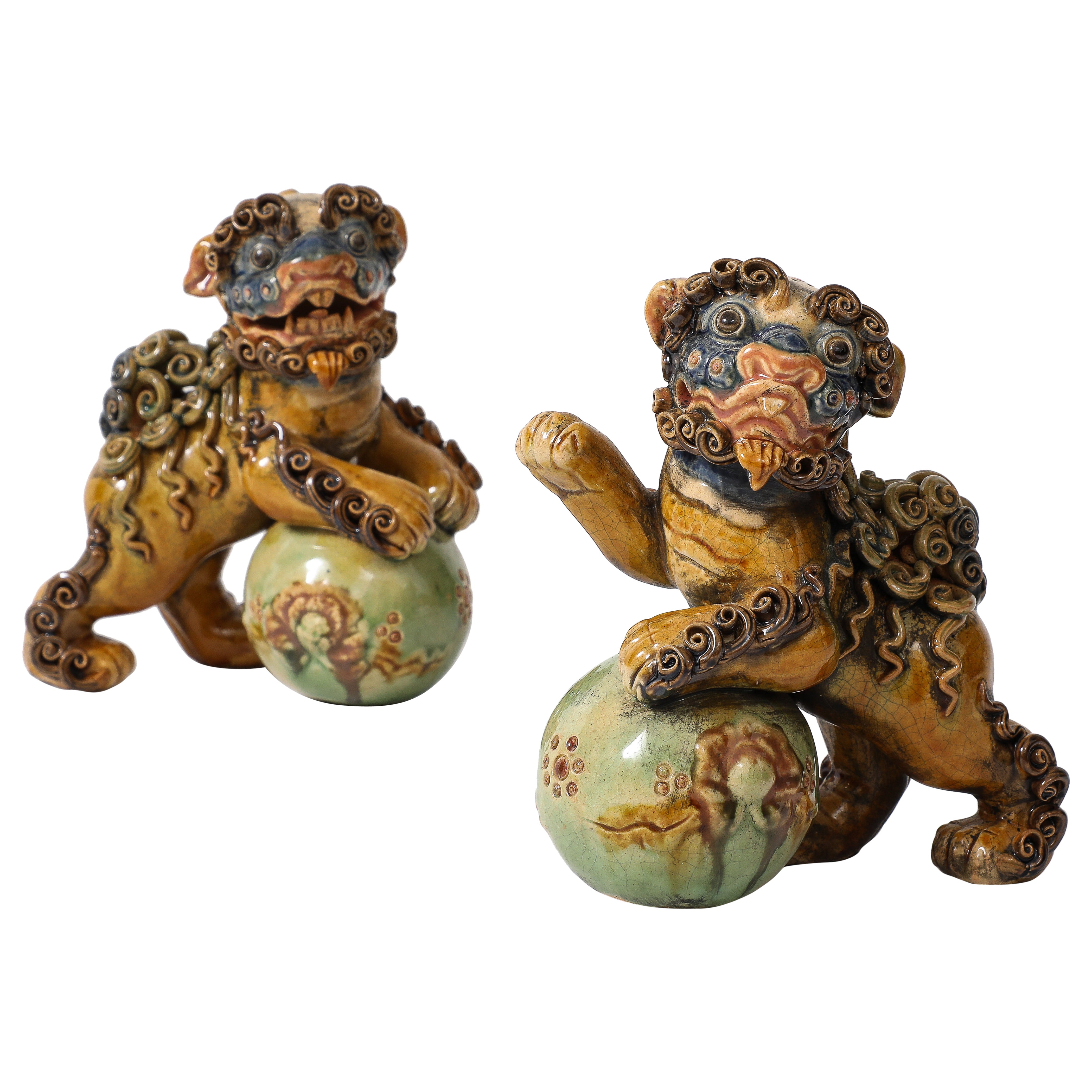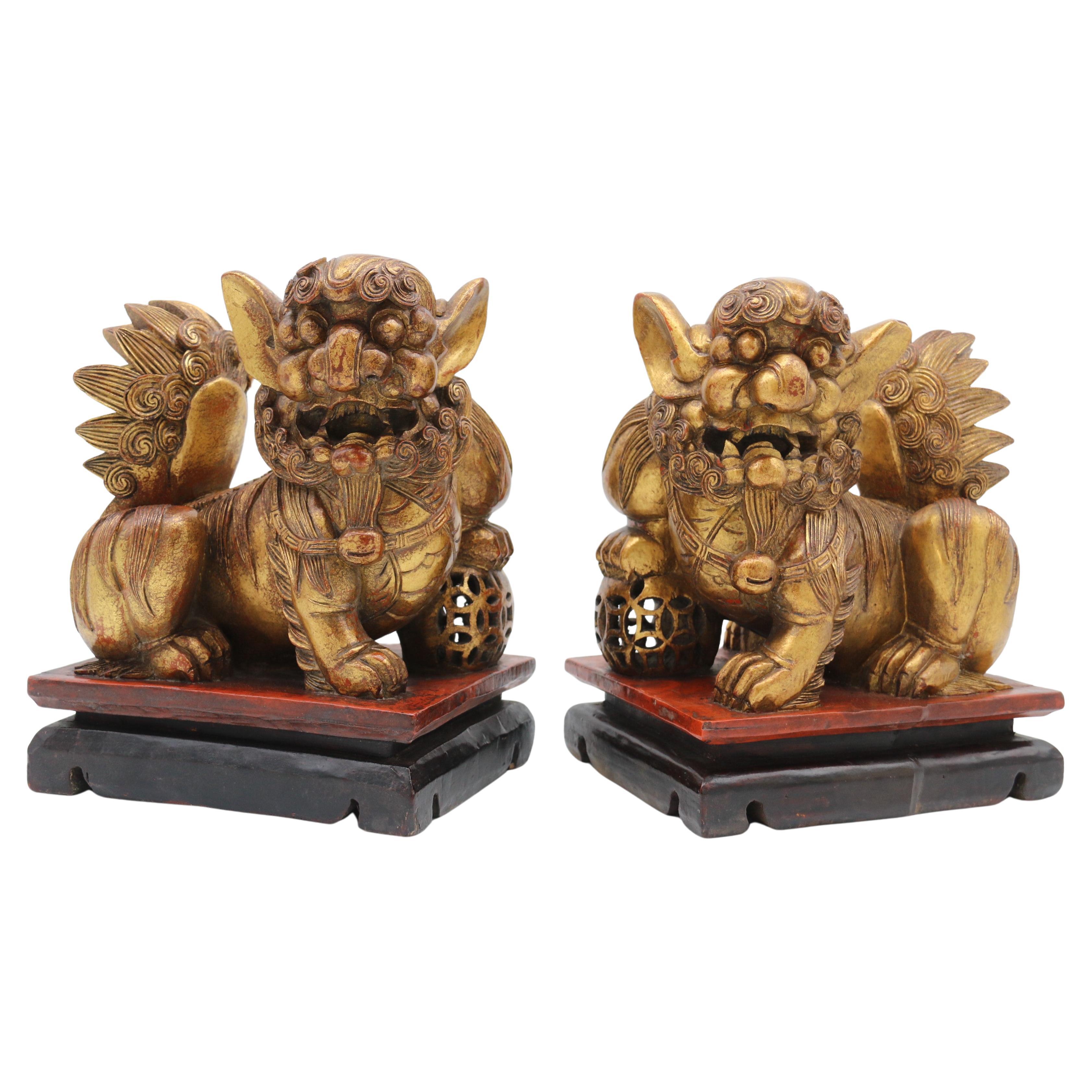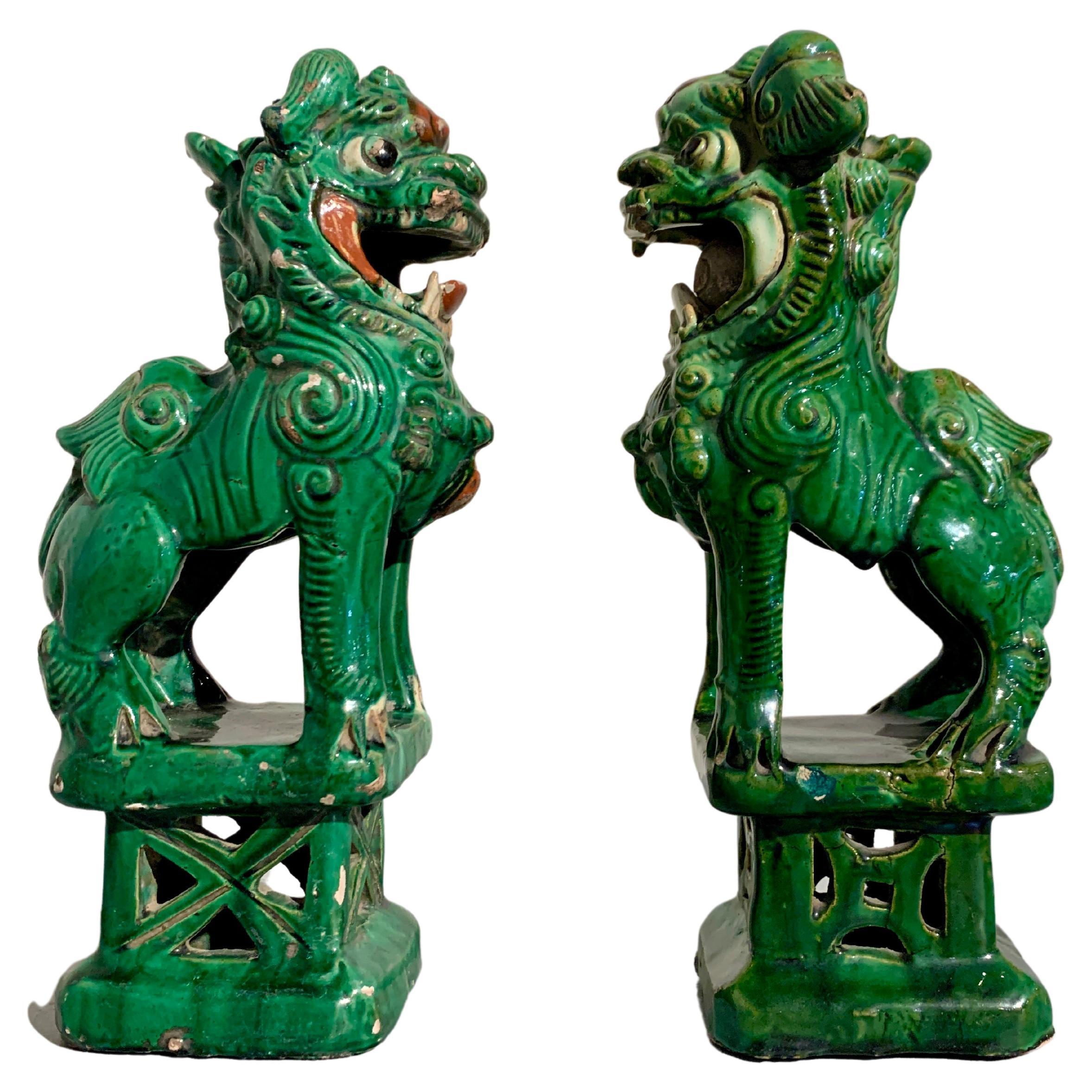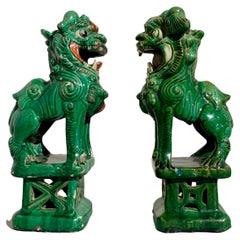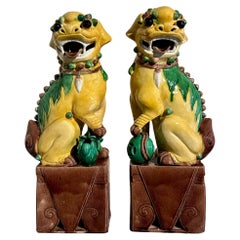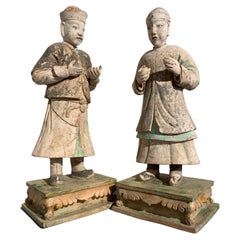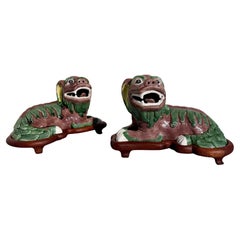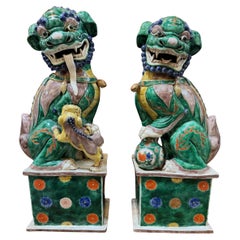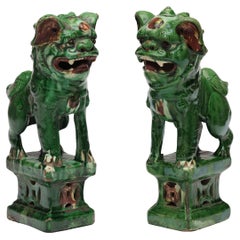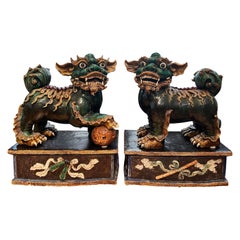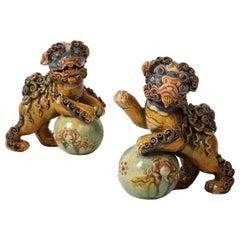Items Similar to Pair Chinese Ming Dynasty Glazed Buddhist Lions and Attendants, 17th Century
Want more images or videos?
Request additional images or videos from the seller
1 of 20
Pair Chinese Ming Dynasty Glazed Buddhist Lions and Attendants, 17th Century
$27,500
£20,881.40
€23,879.44
CA$38,421.49
A$42,733.08
CHF 22,313.89
MX$520,016.15
NOK 284,982.39
SEK 267,263.21
DKK 178,221.43
Shipping
Retrieving quote...The 1stDibs Promise:
Authenticity Guarantee,
Money-Back Guarantee,
24-Hour Cancellation
About the Item
A fantastic pair of large Chinese tileworks sancai glazed Buddhistic lions and attendants, late Ming Dynasty, first half of the 17th century, Shanxi, China. Presented on custom 20th century wood and lacquer table-form stands.
This pair of lions and attendants portray Buddhist lions, and would have flanked a large tileworks image of a Buddha. The bodies of the lions are glazed in the most wonderful shade of blue green. Their bushy and curled manes and tails glazed in a rich brown, the viscous glaze dripping and running beautifully over the blue green glaze of the body. The lions are caparisoned, wearing a harness decorated with lotus blossoms and seed pods, and hung with bells and tassels. Their backs draped with a saddle cloth decorated with a large ruyi lappet. The trappings glazed in mustard yellow and cream. The ornaments and saddle blanket glazed a rich brown, and outlined in cream.
The lions are portrayed with a strong sense of motion. They face each other, stepping forwards, heads slightly turned, mouths open in a wide roar, sharp teeth bared. Their bushy, tripartite tails raised behind them.
A pair of attendants stand in front of them, robes billowing in the wind, or from the roar of the lions. They are dressed as Ming Dynasty officials, wearing heavy robes and boots, with official's caps covering their heads. They hold leads or tethers in their hands, their robust bodies straining to contain the lions.
The lions and attendants are presented on custom lacquered table-form stands. The stands crafted in the Chinese taste, and decorated in lacquer to match the glaze of the sculptures.
- Dimensions:Height: 48.75 in (123.83 cm)Width: 26.25 in (66.68 cm)Depth: 12 in (30.48 cm)
- Style:Ming (Of the Period)
- Materials and Techniques:
- Place of Origin:
- Period:Mid-17th Century
- Date of Manufacture:First Half of the 17th Century
- Condition:Repaired: The tails of both lions broken off at the body, secured, repaired and in-painted. Additions or alterations made to the original: The table stands of 20th century manufacture. Wear consistent with age and use. Minor losses. Minor fading. In very good condition for age. Minor chips to the base of the lions. Kiln adhesion and roughness to some surfaces. The tails of both lions broken and repaired at the body. The stands with minor nicks and scratches to the lacquer.
- Seller Location:Austin, TX
- Reference Number:1stDibs: LU894732312832
About the Seller
5.0
Platinum Seller
Premium sellers with a 4.7+ rating and 24-hour response times
Established in 2001
1stDibs seller since 2010
345 sales on 1stDibs
Typical response time: <1 hour
- ShippingRetrieving quote...Shipping from: Austin, TX
- Return Policy
Authenticity Guarantee
In the unlikely event there’s an issue with an item’s authenticity, contact us within 1 year for a full refund. DetailsMoney-Back Guarantee
If your item is not as described, is damaged in transit, or does not arrive, contact us within 7 days for a full refund. Details24-Hour Cancellation
You have a 24-hour grace period in which to reconsider your purchase, with no questions asked.Vetted Professional Sellers
Our world-class sellers must adhere to strict standards for service and quality, maintaining the integrity of our listings.Price-Match Guarantee
If you find that a seller listed the same item for a lower price elsewhere, we’ll match it.Trusted Global Delivery
Our best-in-class carrier network provides specialized shipping options worldwide, including custom delivery.More From This Seller
View AllChinese Green Glazed Foo Lions, Near Pair, Late 19th Century, China
Located in Austin, TX
A charming near pair of Chinese green glazed foo lion joss stick holders, late 19th century, China.
The delightful foo lions, also referred to as foo dogs, crafted as joss (incens...
Category
Antique Late 19th Century Chinese Qing Sculptures and Carvings
Materials
Stoneware
Pair Vintage Chinese Yellow Glazed Tall Foo Dogs, Mid 20th Century, China
Located in Austin, TX
A fun and colorful pair of vintage Chinese famille jaune glazed porcelain tall (15") foo dogs or foo lions, Chinese export, early to mid 20th century, China.
The delightful pair of ...
Category
Mid-20th Century Chinese Chinese Export Sculptures and Carvings
Materials
Enamel
Pair Large Chinese Ming Dynasty Glazed and Painted Pottery Figures, 16th Century
Located in Austin, TX
A striking pair of large Chinese glazed and painted pottery figures, Ming Dynasty (1368 to 1644), circa 16th century, China.
The impressive and realistically modeled figures each portrayed standing upright upon a sancai (three color) glazed pedestal of kang table form.
The man is dressed in a short black surcoat over a long robe and pants, a smart cap upon his head. His face is warm and welcoming, with wide eyes and a slight smile on his lips. He holds his hands out in front of him, palms up, almost as if shrugging, though presumably originally holding an object or offering, now lost.
The woman of slightly smaller stature, and dressed in a longer surcoat over a long robe and skirt. She wears a fitted cap upon her head. Her hands also held out in front, grasping long lost objects. Her face is slightly more severe, with a somewhat pinched look, and slight frown upon her lips.
The size of these figures is remarkable, as is the realism and attention to detail, almost as if they were modeled after real people, as opposed to the more common and generic Ming Dynasty pottery...
Category
Antique 16th Century Chinese Ming Sculptures and Carvings
Materials
Pottery
Pair Chinese Export Famille Verte Biscuit Porcelain Foo Lions, mid 20th Century
Located in Austin, TX
A charming and delightful matched pair of recumbent Chinese Export porcelain foo lions or foo dogs, famille verte enameled biscuit porcelain and carved hardwood stands, mid 20th cent...
Category
Mid-20th Century Chinese Chinese Export Ceramics
Materials
Enamel
Pair of Tang Dynasty Sancai Glazed Tomb Guardians, Zhenmushou, 7th-8th Century
Located in Austin, TX
A fantastic and powerful pair of Chinese Tang Dynasty three-color (sancai) glazed zhenmushou, tomb guardian figures, late 7th or early 8th century. TL t...
Category
Antique 15th Century and Earlier Chinese Tang Sculptures and Carvings
Materials
Earthenware
Pair Small Chinese Dragon Vases, Molded and Glazed Porcelain, Republic Period
Located in Austin, TX
A fabulous pair of small Chinese molded and glazed biscuit ware porcelain dragon vases with loose eyes and apocryphal Qianlong mark, Republic Period, circa 1920, China.
The small ...
Category
Vintage 1920s Chinese Qing Ceramics
Materials
Porcelain
You May Also Like
Pair of Chinese Famille Verte Male and Female Buddhist Lions
Located in Stamford, CT
Pair of Chinese Famille Verte male and female Buddhist lions in the style of the Kangxi period (1661-1722). Each stands on a plinth, one with its head to one side and having its jaw ...
Category
Late 20th Century Chinese Ceramics
Materials
Ceramic
Pair of Chinese Sancai Fu Lion Protectors, c. 1850
Located in Chicago, IL
Believed to be powerful protectors against malevolent spirits, fu lion dogs have stood guard at the entryways and thresholds of Chinese homes for centuries. This pair of small cerami...
Category
Antique Mid-19th Century Chinese Qing Figurative Sculptures
Materials
Stoneware
Pair Of 19th Century Chinese Foo Dogs On Stands
Located in Houston, TX
Pair Of 19th Century Chinese Foo Dogs On Stands.
Stunning large pair of antique Chinese beautifully hand decorated glazed ceramic foo dog...
Category
Antique 19th Century Chinese Chinese Export Ceramics
Materials
Ceramic
$7,250 / set
Pair of Qing Dynasty Foo Dog Lions, China circa 1950
Located in New York, NY
Pair of charming polychrome ceramic Foo Dog / Lions in the Qing Style. Fantastic detail and a beautiful color combination of ochre, green, brown and blue. Foo dogs are symbolic, pro...
Category
20th Century Chinese Qing Ceramics
Materials
Ceramic
A decorative pair of carved gilt wood and lacquer Chinese Buddhist lions C 1900
Located in Central England, GB
A very pleasing and beautifully hand carved pair of Chinese Buddhist lions left and right handed and raised onto stepped rectangular plinths all carved from the same section of timbe...
Category
Early 20th Century Chinese Chinese Export Sculptures and Carvings
Materials
Giltwood, Lacquer
Pair of Vintage Chinese Red and Gilt Buddhistic Lions
Located in Hopewell, NJ
Regal pair of carved wooden Chinese red painted and gilt Buddhistic lions. Each lion is seated atop a cloth draped plinth, with one paw atop a brocade ball. The lion is a symbol of s...
Category
Vintage 1920s Chinese Animal Sculptures
Materials
Wood
More Ways To Browse
Chinese Lions
Glazed Lion
Antique Chinese Lions
Lion Head Wood Furniture
Dress Form Mid Century
Lion Head Sculpture
Chinese Yellow Glaze
17th Century Wood Carving
17th Century Lion
Lion Wood Sculpture
Chinese Lions Pair
Chinese Bell
Lion Dress
Lions Wood Carvings
Cream Ceramic Sculpture
Saddle Chinese
Ming Dynasty Table
Green Ming Dynasty

